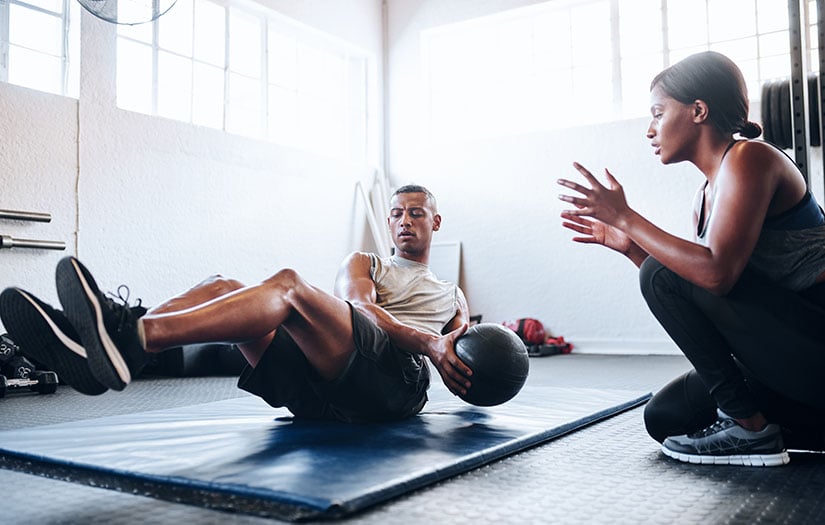You may have heard the term ‘muscle memory’ to describe the ability to remember movements, or maybe to describe the ability to quickly regain muscle mass that is lost after periods of inactivity.
When this term is thrown around casually as a marketing tool for an exercise program, it might cause you to wonder, “Is muscle memory a thing? Can my muscles remember my workout?”
Short answer: Yes, muscle memory is real, but it might not work as you think.
As a fitness trainer or enthusiast, this subject is an important one to consider.
What is Muscle Memory?
Muscle memory describes the ability to regain muscle mass in previously trained muscles. This means that once you’ve gained muscle mass through strength training if you lose it after taking time off from training, you can regain the muscle mass faster than the amount of time that it took to put it on in the first place.
This is good news!
How Does Muscle Memory Work?
Muscle memory doesn’t have to do with your muscle cells “remembering” exercise. As your muscles are trained, the number of muscle fiber nuclei, or myonuclei, can increase as muscle mass increases. There is still debate within the scientific community about the volume of strength training required for myonuclei to increase in number.
In a research review by Snijders et. al. (2020), data shows a linear relationship between muscle fiber size and the number of myonuclei in humans. This would suggest that hypertrophy training, and an increase in muscle size, would increase myonuclei.
The question that researchers are still debating is: What happens to the myonuclei during periods of inactivity? If you gain muscle mass, but then stop training, do you lose all the myonuclei that were gained during training?
Research performed on animals by Egner et al. (2013) shows that myonuclei that are gained during overload hypertrophy are not lost during 3 months of muscle atrophy when the muscle returns to its original size. Even though the muscle size decreased during this period of inactivity, the number of myonuclei did not. This research seemed very promising because it suggested that even though the muscle size decreased, the potential for faster muscle re-growth was there since the number of myonuclei was retained.
This is potentially good news for aging adults and those who may have had to take time off for training due to various reasons (like a pandemic, for example). There is some promising research in humans that suggests that myonuclei are retained after short-term physical inactivity and that rapid muscle re-gain is possible (Snijders et al., 2020). There is still a limited amount of research to fully support this view, however, so it is important to consider the current limitations of research.
Limitations of Muscle Memory
For some time, it was hypothesized that the increase in myonuclei in humans might be long-lasting or even permanent. At this time, the length of time that muscle memory lasts are uncertain. A review of research on muscle memory from Snijders, et al. (2020) found that “there is no consensus within the scientific community on the existence of muscle memory by myonuclear permanence in human skeletal muscle and more research is warranted using properly designed intervention studies.”
Further research is needed to form a more conclusive consensus on the lifespan of myonuclei that are gained through training and the implication of muscle re-growth.
It’s important to note that muscle memory is NOT the ability of the muscles to remember movements. The term muscle memory can be a bit of a misnomer because muscles don’t technically remember anything. In the brain, information is encoded, stored, and retrieved. What we perceive as the muscles “remembering” refers to motor learning that occurs in the central nervous system (CNS), not the muscles.
If you’ve ever taken years off from riding a bike, you may be surprised that after just a few wobbly moments, you’re riding as if you never took time off. Your brain remembers how to ride the bike, and you remain upright.
It is fair to say, however, that there is a neural component to muscle memory since someone who has performed an exercise before will do so more efficiently than someone who has not which may aid efforts to gain muscle mass.
How to Use the Concept of Muscle Memory for Hypertrophy
Muscle memory can be a game-changer for anyone who has had to take a break from training due to vacation, injury, or life events. Even though there is still some debate when it comes to muscle memory, we can still apply what we do know to take advantage.
There are two factors to consider when utilizing muscle memory:
1. Perform an adequate volume of training to induce muscle hypertrophy. To elicit the adaptation of muscle hypertrophy, one must strength train consistently (3-4 times per week) at a volume of 3-5 sets of 6-12 repetitions of exercises for 4-6 weeks. Someone who is just starting to train will need to work up to that intensity and volume by beginning with Stabilization Endurance Training and Strength Endurance training, which take 8 weeks to complete in total.
2. Minimize periods of inactivity, if possible. The longer you rest, the more muscle atrophy takes place. Additionally, the less activity you do during that rest, the higher the rate of atrophy. Taking a week off from your normal workout routine will hardly dent your progress but lying still in bed for 3 weeks can lead to significant atrophy. If possible, stay as active as possible while taking a break from strength training to minimize muscle mass loss.
How Long Does It Take to Get Back Into Shape?
One of the first studies to see more rapid re-growth in resistance training was performed by Staron et al. in 1991. In this study, the female participants regained their muscle strength and fiber size during 6 weeks of retraining compared to the initial 20 weeks of strength training.
However, it seems that the rate at which muscle is re-gained can vary dependent on the level of inactivity that occurs during the lapse in training (Snijders et al., 2020). If you are bedridden for some time, it will likely take longer to get back into shape than if you simply stop resistance training but continue to do normal daily activities.
Consider this to be encouraging news if you, like many, took time off from training during the pandemic (or for any other reason!). There’s no time like the present to pick up those dumbbells again and remind those muscles how good it feels to lift. It might feel like you’re back at square one initially, but the gains will come back in no time.
References:
Egner, I. M., Bruusgaard, J. C., Eftestøl, E. and Gundersen, K. (2013). A cellular memory mechanism aids overload hypertrophy in muscle long after an episodic exposure to anabolic steroids. J. Physiol. 591, 6221-6230. https://doi.org/10.1113/jphysiol.2013.264457
Gundersen, K. (2016). Muscle memory and a new cellular model for muscle atrophy and hypertrophy. J Exp Biol, 219(2), 235-242. https://doi.org/10.1242/jeb.124495
Snijders, S. et al. (2020). The concept of skeletal muscle memory: Evidence from animal and human studies. Acta Physiol (Oxf), 229(3), e13465. https://doi.org/10.1111/apha.13465

















